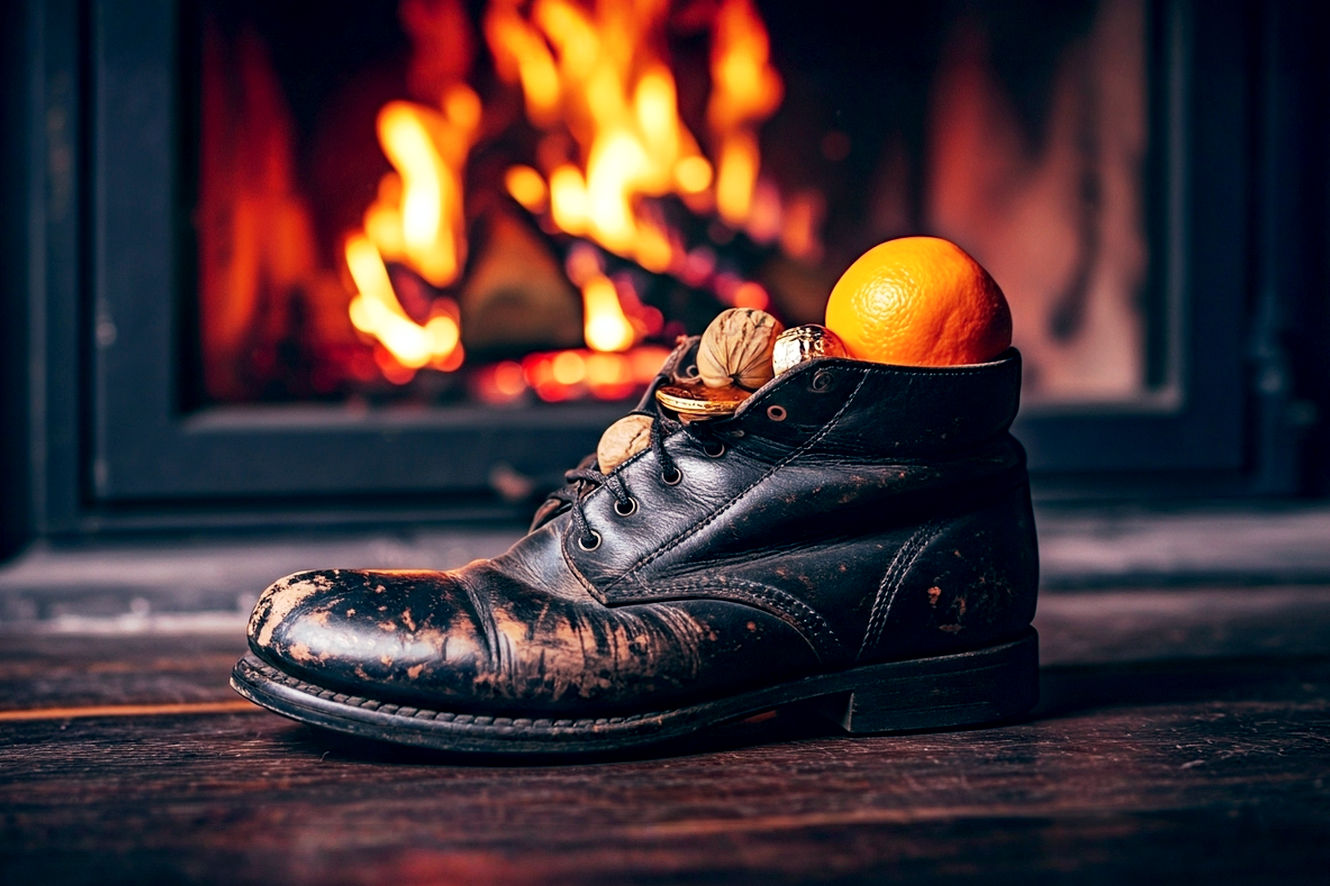This post may contain affiliate links. If you make a purchase through these links, we may earn a commission at no additional cost to you.
Of all the ornaments that grace the boughs of a Christmas tree, the candy cane is perhaps the most charmingly deceptive. It hangs there, a simple, elegant hook of red and white, seeming to have always belonged. It’s a treat for the eyes and the taste buds, a nostalgic symbol so deeply woven into the fabric of the holiday season that we rarely stop to question its origins. But behind that sweet peppermint snap lies a fascinating, centuries-long story, a winding path of myth, migration, faith, and industrial ingenuity.
This isn’t just the story of a piece of candy. It’s the story of how a straight, all-white sugar stick, likely created for medicinal purposes, transformed into a curved, striped icon of Christmas. It’s a tale that travels from the hallowed halls of a German cathedral to a small town in Ohio, and from the painstaking work of artisan confectioners to the revolutionary automated factories of the American South.
The Enduring Legend: A Shepherd’s Crook in Cologne
Nearly every investigation into the candy cane’s past begins in the same place: 17th-century Germany, with a story that has all the ingredients of a perfect Christmas fable. It’s a tale of restless children, a creative choirmaster, and a clever solution that would echo through the ages.
The Story of the Choirmaster
As the legend goes, the year is 1670, and the setting is the magnificent Cologne Cathedral in Germany. The choirmaster was facing a familiar problem: keeping the young singers quiet during the long, solemn Living Creche ceremony. The children, filled with yuletide excitement, would fidget and chatter, disrupting the nativity service. Desperate for a solution that wouldn’t seem entirely out of place in a church, he sought the help of a local candy maker.
He asked the confectioner to create sweet sticks for the children to suck on, hoping the treat would keep them occupied. But to justify handing out candy during a sacred service, he added a touch of genius. He asked the candy maker to bend the top of each stick, forming a shepherd’s crook or crosier. This simple curve transformed the candy from a mere sweet into a teaching tool, a reminder of the shepherds who visited the baby Jesus on that first Christmas night. The all-white sticks, representing the sinless, pure life of Jesus, were a hit. The children were quiet, the choirmaster was relieved, and a tradition was supposedly born.
Fact-Checking the Folklore: Why It’s Likely a Myth
It’s a wonderful story, isn’t it? It connects the candy cane directly to the heart of the Christmas narrative and gives it a wholesome, pious origin. There’s just one problem: there is virtually no historical evidence to support it.
Church records from the Cologne Cathedral, which are quite extensive, make no mention of this choirmaster or his clever candy solution. Confectioners’ guild records from the period are similarly silent. The story doesn’t appear in print until centuries later, bearing all the hallmarks of a retrofitted folk tale—a story created after the fact to explain a tradition whose true origins had become murky.
While it’s possible something like this happened on a small, undocumented scale, historians widely agree that the Cologne legend is just that—a legend. The real history is less a single, neat narrative and more a slow, meandering evolution.
From Straight White Sticks to a Curved Icon: The Verifiable History
The candy cane didn’t spring into existence fully formed. Its key features—the sugar base, the J-shape, the red stripes, and the peppermint flavor—were all added incrementally over hundreds of years.
The 17th Century: Sugar Sticks and “Sugar-Works”
Long before the Cologne legend was ever imagined, straight, white sugar sticks were already popular across Europe. Sugar, once an expensive luxury, was becoming more accessible in the 17th century. Confectioners, often doubling as apothecaries, would create “sugar-works”—intricate sculptures and simple pulled-sugar candies. These hard, white sticks were enjoyed by adults and children alike and were sometimes used to soothe sore throats or upset stomachs, often infused with flavors like lemon or rosewater.
These were the direct ancestors of the candy cane. For a long time, they remained simple, straight, and white. The two innovations that would define the modern candy cane—the hook and the stripes—were still far in the future.
The German-American Connection: The Candy Cane Crosses the Atlantic
The tradition of decorating Christmas trees began in Germany in the 16th century. Early trees were adorned with natural items like apples, nuts, and paper roses. As confectionary arts advanced, edible ornaments, including cookies and sugar candies, became popular additions. It seems logical that German families would eventually hang the common white sugar sticks from their tree branches.
But how did they hang them? This is where the story takes a crucial turn and crosses an ocean.
August Imgard and the First Tree in Wooster, Ohio
The first documented appearance of candy canes on a Christmas tree in the United States is credited to August Imgard, a German-Swedish immigrant living in Wooster, Ohio. In 1847, Imgard decided to decorate a small blue spruce in his home to share the beloved Christmas traditions of his homeland with his American family and neighbors.
According to local history, he decorated the tree with paper ornaments and, most importantly, white candy canes, which he hung from the branches alongside cookies. This event is widely cited as the moment the candy cane tradition was introduced to America. The Wooster community still commemorates Imgard’s tree, and it marks the first solid historical anchor point for candy canes being used as Christmas tree ornaments.
The Crucial Curve: A Hook Is Born
The Imgard story highlights a key development. The candies he used were canes, not straight sticks. The bend, whether it was originally symbolic or not, served an obvious and essential practical purpose: it allowed the candy to be hung on a tree branch without needing string or wire.
It’s impossible to know for sure who first bent the sugar stick. It may have been the apocryphal choirmaster, an anonymous German family wanting to decorate their Tannenbaum, or a clever confectioner looking for a new design. What we do know is that by the mid-19th century, when Imgard decorated his tree, the hooked shape was established enough to be considered a traditional ornament. The function of the hook was now inseparable from its form.
Painting the Town Red (and White): The Arrival of Stripes and Flavor
For decades, the candy canes hanging on Christmas trees remained pure white. The iconic red stripes and peppermint flavor that we consider essential today were later additions, products of the late Victorian and early Edwardian eras.
Evidence from Christmas cards, illustrations, and literature suggests that the red stripes began appearing around the turn of the 20th century. One of the earliest visual records is a Christmas card printed in the late 1890s that shows a candy cane with red stripes. By the early 1900s, recipes for striped peppermint canes began appearing in confectionary journals.
Why red? The color has long been associated with Christmas, symbolizing everything from Santa’s suit to holly berries. For candy makers, adding a stripe was a way to make their product more visually appealing and festive, helping it stand out in a growing market of Christmas treats.
At the same time, peppermint became the dominant flavor. While early sugar sticks came in various flavors, peppermint’s bracing, clean taste and scent became inextricably linked with the winter season. Its aroma, mingling with the scent of pine from the tree, created a multi-sensory Christmas experience that cemented the candy cane’s place in holiday traditions.
The Industrial Revolution of Candy: How the Cane Became a Christmas Staple
By the early 20th century, all the elements of the modern candy cane were in place. But it was still a regional treat, made by hand in local candy kitchens. The process was laborious, time-consuming, and fraught with challenges, which kept the candy relatively expensive and limited in supply. For the candy cane to become the ubiquitous symbol it is today, it needed an industrial revolution.
The Pre-Industrial Struggle: A Labor of Love and Breakage
Making candy canes by hand was an art form. Confectioners would cook sugar, corn syrup, and water to a precise temperature. They would then pull and knead the hot, pliable sugar mass to aerate it, which gives the candy its opaque white color and brittle texture. For striped canes, a smaller portion of the candy would be colored red and then skillfully wrapped around the white log before it was rolled and stretched into long ropes.
The most difficult part was the bend. The hot sugar had to be cut and bent into the “J” shape at just the right moment. Too soon, and it would be too soft to hold its shape; too late, and it would be too brittle and shatter. Breakage rates were incredibly high—by some estimates, over 20% of the candy was lost during the bending process. This waste and intensive labor meant that candy canes could never be a true mass-market product.
A Priest’s Ingenuity: Father Keller’s Bending Machine
The solution to the bending problem came from a rather unexpected source: the Catholic Church. A Roman Catholic priest named Father Gregory Keller invented a machine to automate the process. While details about Father Keller are scarce, his invention, the Keller Machine, was a game-changer.
The machine automated the final, most delicate steps of candy cane production. It would take the warm, straight ropes of candy, cut them to a consistent length, and then perfectly bend them into the iconic crook shape, all without the high rates of breakage that plagued manual methods. Father Keller, acting on behalf of his brother-in-law, Bob McCormack, who owned a candy company, patented the machine in the 1950s.
Bob’s Candies and the Dawn of Mass Production
Bob McCormack, the founder of Bob’s Candies in Albany, Georgia, was the visionary who saw the potential of the Keller Machine. His company had been making candy canes by hand since the 1920s, and he was all too familiar with the production bottlenecks. After his brother-in-law, Father Keller, developed the machine, McCormack’s company began to implement and perfect the technology.
The impact was immediate and profound. Production soared, while costs and waste plummeted. Bob’s Candies could now produce candy canes on a scale previously unimaginable. They could be shipped across the country, sold at affordable prices, and marketed as a Christmas essential. By the late 1950s, Bob’s Candies had become the world’s leading producer of candy canes, and Albany, Georgia, became known as the “Candy Cane Capital of the World.”
The Keller Machine and the McCormack family’s business acumen are the primary reasons the candy cane transformed from a charming, handmade ornament into a multi-million-dollar industry and an accessible treat for nearly every American family.
Unpacking the Symbolism: Faith, Purity, and Peppermint
While the historical origins of the candy cane are rooted in practicality and commerce, its cultural power comes from the rich layers of symbolism that have been attached to it over time. These interpretations, mostly Christian in nature, have become just as much a part of the candy cane’s story as its factual history.
It’s crucial to understand that these meanings were almost certainly retrofitted—applied to the candy long after it was created. There’s no evidence that the original makers had these ideas in mind, but that doesn’t diminish the importance of the symbolism to millions of people today.
The Shepherd’s Staff and the “J” for Jesus
The most widely cited meaning is the one from the Cologne legend. The shape is seen as a shepherd’s crook, representing Jesus as the “Good Shepherd” who watches over his flock. This imagery is deeply rooted in biblical tradition and provides a direct link between the candy and the Christian narrative of Christmas.
A related interpretation suggests the shape is a “J” for Jesus. This is a simple, powerful, and easily remembered explanation that further solidifies the candy’s identity as a Christian symbol.
The Meaning of the Colors: Red and White
The colors of the candy cane are also imbued with deep religious meaning:
- The White: The broad white stripes are said to represent the purity of the Virgin Mary and the sinless, perfect nature of Jesus. It symbolizes a clean slate, a life free from transgression.
- The Red: The bold red stripe (or stripes) is interpreted as a symbol of the blood that Jesus shed for humanity on the cross. It represents his sacrifice, love, and the redemption offered to believers.
Together, the colors tell a story of purity and sacrifice, a core tenet of the Christian faith.
The Hyssop Connection: Why Peppermint?
Even the flavor has been given a symbolic interpretation. Some Christian traditions connect the peppermint flavor to the biblical plant hyssop. In the Old Testament, hyssop was an herb used for purification and sacrifice. Its strong, cleansing scent and flavor are seen as parallel to the purifying power of Jesus. While this connection is more tenuous than the others, it completes the candy cane’s symbolic transformation into a multi-faceted representation of Christian beliefs.
A Retrofitted Meaning: When Symbolism Meets History
For the historian, the story is one of practicality: a sugar stick was bent to hang on a tree, and stripes were added to make it prettier. For the person of faith, the story is one of meaning: a symbol of Jesus, his purity, and his sacrifice.
The beauty of the candy cane is that both can be true simultaneously. The tradition thrives in the space where history and legend, commerce and faith, intersect. The retrofitted symbolism, spread through Sunday school lessons, Christmas cards, and family stories, has given the candy cane a depth and resonance that a simple sugar stick could never have achieved on its own.
The Candy Cane on the Christmas Tree: A Perfect Pairing
Why did the candy cane, above all other candies, become the quintessential Christmas tree ornament? The answer lies in a perfect storm of practicality, aesthetics, and sensory appeal.
An Ornament Born of Practicality
As we’ve seen, the hook was a stroke of functional genius. In an era before commercially produced ornament hooks, the candy cane was self-sufficient. It was cheap, readily available (especially after mass production), and easy for even the smallest child to hang on a branch. It was, in many ways, the perfect DIY ornament.
From Edible Decoration to Nostalgic Icon
The candy cane is one of the few ornaments that is also a treat. This dual nature made it especially magical for children. The anticipation of being allowed to finally eat the ornaments after Christmas was a powerful part of the holiday experience.
Over generations, this experience created a deep sense of nostalgia. The sight, smell, and taste of a candy cane can instantly transport people back to the Christmases of their childhood. It’s a tradition passed down from parents to children, a tangible link between past and present celebrations. This emotional weight is perhaps the single biggest reason for its enduring popularity.
The Sensory Experience: Sight, Scent, and Taste
The candy cane engages multiple senses, embedding it deeply in our holiday memories.
- Sight: The crisp, graphic pattern of red and white stripes provides a beautiful visual contrast against the deep green of the pine needles.
- Scent: The fresh, invigorating scent of peppermint mingles with the earthy aroma of the tree, creating the signature fragrance of Christmas.
- Taste: The cool, sweet rush of peppermint is a flavor we associate almost exclusively with the holiday season.
This trifecta of sensory input makes the candy cane a uniquely powerful and memorable part of the Christmas tree tradition.
The Modern Candy Cane: Evolution of a Classic
While the classic red-and-white peppermint cane remains the standard-bearer, the tradition continues to evolve. The modern candy cane is a testament to creativity, consumer demand, and a willingness to play with a classic formula.
A Rainbow of Flavors and Colors
Today, you can find candy canes in a dizzying array of flavors and colors. The “J” shape has become a canvas for confectionary experimentation. You can find everything from sweet and fruity flavors like cherry, blueberry, and watermelon to more… adventurous options like pickle, bacon, and wasabi. The colors have followed suit, with canes appearing in every shade of the rainbow to match different decorating schemes or flavor profiles.
Beyond the Tree: Candy Canes in Cuisine and Crafts
The candy cane has broken free from the branches of the Christmas tree and found its way into nearly every corner of holiday culture.
- In the Kitchen: Crushed candy canes are a popular ingredient in holiday baking, sprinkled over cookies, brownies, and cakes. They are stirred into hot chocolate, used to rim cocktail glasses, and infused into vodkas and liqueurs.
- In Crafts: The iconic shape is used in countless holiday crafts, from wreaths and table centerpieces to homemade ornaments made from felt, beads, or pipe cleaners.
The Candy Cane in Popular Culture
The candy cane is a reliable visual shorthand for Christmas in movies, television shows, and advertising. It instantly signals the holiday season. From being a key food group for Buddy the Elf to decorating the landscapes of animated Christmas specials, the candy cane is a universally understood symbol of festive cheer.
A Practical Guide to the Tradition
For those looking to fully embrace the tradition, here are a few tips for incorporating candy canes into your holiday celebration.
Tips for Decorating Your Tree with Candy Canes
- Distribution: Scatter them evenly around the tree. Don’t be afraid to hang some deeper inside the branches, not just on the tips, to create depth.
- Real vs. Artificial: On a real tree, the branches are often sturdier and more varied, providing natural-looking perches. On an artificial tree, you may need to gently bend the branches slightly to secure the canes.
- Mix and Match: Combine classic peppermint canes with some of the newer colors and flavors for a modern twist. You can also mix full-size canes with miniature ones.
Keeping Them Fresh: The Battle Against Humidity
The arch-nemesis of the hard candy cane is humidity. If left exposed to moist air for too long, they can become sticky and soft.
- Keep the Wrapper On: For canes you plan to eat later, it’s best to leave the plastic wrapper on while they hang on the tree. This will protect them from air and moisture.
- Store Properly: Store any unused candy canes in an airtight container in a cool, dry place. Don’t refrigerate them, as this can cause them to become sticky.
A Taste of Tradition: The Basics of Making Your Own
If you’re feeling adventurous, you can try making your own candy canes. It’s a challenging but rewarding process. You’ll need a candy thermometer, a silicone mat, and a good deal of patience. The basic steps involve:
- Cooking sugar, corn syrup, water, and peppermint extract to the “hard crack” stage (around 300°F / 150°C).
- Pouring the molten candy onto a heatproof surface.
- Separating a small portion and coloring it red.
- Pulling and folding the white candy to incorporate air.
- Wrapping the red candy around the white log.
- Rolling, stretching, cutting, and bending the canes into shape before they cool and harden.
It’s a sticky, tricky business, but one that will give you a profound appreciation for the confectioners who perfected this art form.
Conclusion: The Enduring Magic of a Simple Stripe
The candy cane is so much more than sugar and peppermint. It’s a symbol born of legend, shaped by practicality, and perfected by industry. It’s a canvas for faith, a vessel for nostalgia, and a cornerstone of the sensory experience of Christmas.
Its journey from a straight, white medicinal stick to the beloved ornament we know today is a microcosm of the Christmas season itself—a blend of the sacred and the secular, the ancient and the modern, the handmade and the mass-produced. It reminds us that traditions are not static things, but living, evolving stories that we add to with each passing year.
So, the next time you hang a candy cane on a green bough, take a moment to appreciate the centuries of history, myth, and meaning packed into that simple, sweet hook. It’s a story of how the most unassuming objects can come to hold our most cherished memories.






